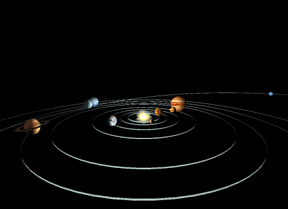Click on image for full size
Courtesy of KASI - CBNU - ARCSEC (KASI is the Korea Astronomy and Space Science Institute, CBNU is the Chungbuk National University, and ARCSEC is Astrophysical Research Center for the Structure and Evolution of the Cosmos.)
A Newly Discovered Solar System Contains Scaled-Down Versions of Saturn and Jupiter
News story originally written on February 14, 2008
For a long time, scientists have wondered if there are other systems of planets like our own in our galaxy. Recently a team of astronomers discovered a solar system almost 5,000 light years away that has smaller versions of Jupiter and Saturn. This discovery means that there might actually be star systems similar to our solar system.
The new solar system seems to be a smaller version of our own. One of the planets in this solar system has almost three-quarters of Jupiter's mass and another has 90 percent of Saturn's mass. The sun they orbit has about half the mass of our sun. Although their sun is is not as bright as our sun, temperatures at both planets are probably the same as temperatures on Jupiter and Saturn because they are closer to their star.
When astronomers observe a star through a telescope, the light waves usually travel straight from the star to the telescope; but if another star passes in between the telescope and the star they are looking at, the closer star acts like a lens and magnifies the incoming light. The telescope can't show a lot of details, but if there are planets orbiting around the closer star, the view from the telescope will show a brighter light where there is a planet. Astronomers can use this information to tell how large the planet is and how far away it is from its star.
This is what happened when the astronomers discovered the new solar system. While they were looking at one star another, another star that is closer to Earth passed in front of the star they were observing. The light from the stars became brighter and the astronomers were able to tell that there were planets like Jupiter and Saturn orbiting around the star.
Scott Gaudi, one of the astronomers who worked on this project, said that while people might think it was lucky that they were able to see this new solar system, he thinks "it might just mean that these systems are common throughout our galaxy."















